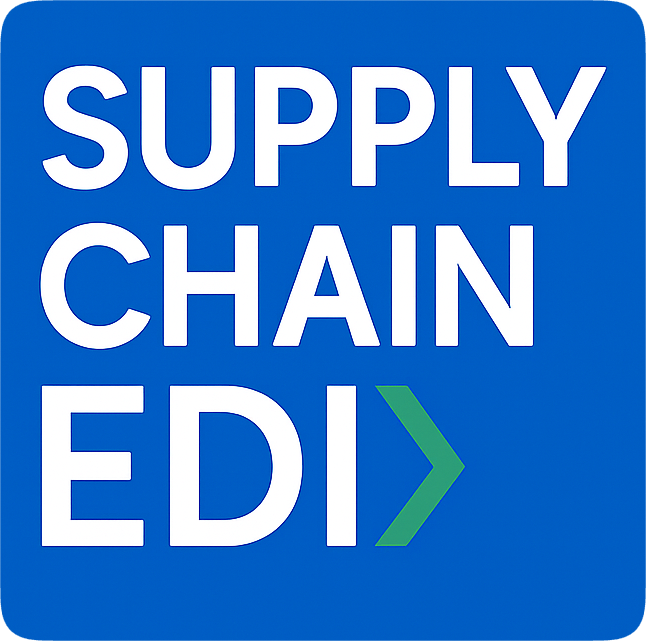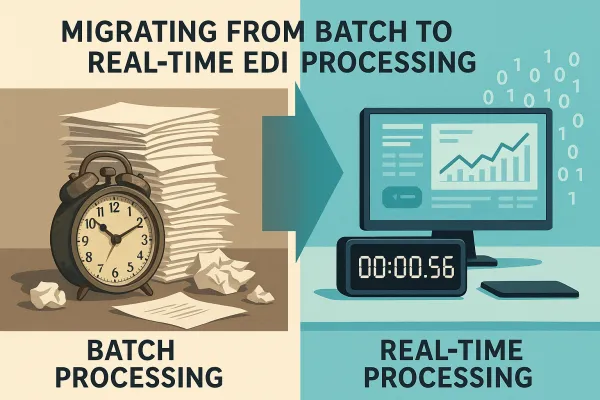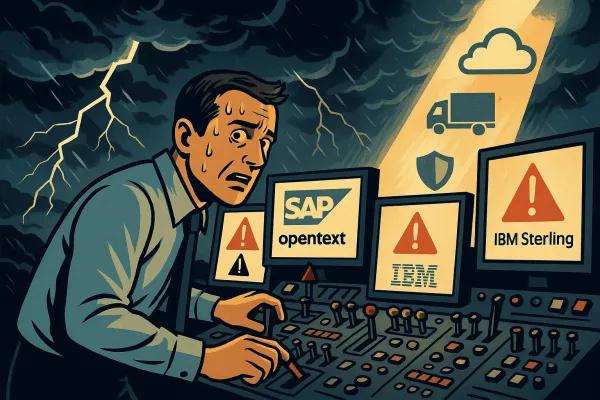The Complete EDI Supplier Security Assessment Framework: How to Prevent Third-Party Cyber Attacks That Target 45% of Supply Chains in 2025

Your third-party EDI providers handle some of your most sensitive supply chain data, yet third-party involvement in breaches has doubled, rising from 15% to nearly 30%, according to the 2025 Verizon Data Breach Investigations Report. That supplier you trust with purchase orders, shipping notices, and invoicing data? The vector "third-party vendor and supply chain compromise" costs an average of USD 4.91 million when things go wrong.
The reality hits harder when you consider that 45% of organizations will have experienced a software supply chain attack by 2025, according to Gartner forecasts. Your EDI supplier security assessment framework isn't just another compliance checklist - it's your primary defense against becoming part of that statistic.
The Hidden EDI Security Crisis: Why Third-Party Suppliers Are Your Biggest Vulnerability
Faxinating Solutions, a Quebec-based EDI provider serving some of the largest shippers in North America, including Walmart, Costco and Loblaws, learned this lesson the hard way. Despite serving approximately 20,000 companies through 1,200 direct customers, the company fell victim to a ransomware attack that highlighted just how exposed even established EDI networks can be.
The attack didn't target their secure AS2 EDI systems directly. Instead, the attack stemmed from a sophisticated phishing email, demonstrating how threat actors find creative ways around technical security controls. While the production EDI environment remained uncompromised, the incident shows why traditional security thinking falls short when evaluating EDI supplier security.
Here's what makes EDI connections particularly vulnerable: they operate with privileged access to your most critical business data. Purchase orders, shipping notices, invoices, and inventory data flow through these systems 24/7. The top breach vectors in 2025 include third-party vendor access (18%), phishing attacks (16%), and compromised credentials (11%) - all attack methods that can target EDI providers.
The $4.91 Million Cost of EDI Supplier Breaches
The financial impact extends far beyond the immediate breach costs. Supply chain attacks now cost 17 times more to remediate than direct (first-party) breaches. For industrial sector companies, which rely heavily on EDI for supplier coordination, the average breach cost hit $5.56 million in 2024 – an 18% jump over the previous year. Notably, unscheduled downtime in this sector may cost up to $125,000 per hour.
Hidden costs multiply quickly. Your EDI supplier breach doesn't just affect one system - it cascades through your entire supplier network. Orders stop flowing, shipments get delayed, and your team scrambles to implement manual processes while systems get restored. Regulatory notifications become mandatory in many jurisdictions, and customer trust erodes as supply chain disruptions become visible.
The 5-Step EDI Supplier Security Assessment Framework
Most organizations evaluate third-party EDI security once during vendor selection, then annually thereafter. Most companies still evaluate third-party risk once a year – a static snapshot in a dynamic environment. Threat actors, on the other hand, exploit these blind spots in real time. Your assessment framework needs to match the pace of evolving threats.
Step 1: Comprehensive vendor inventory and risk categorization
Document every EDI connection, API integration, and data flow. Classify suppliers based on data sensitivity and business impact. Your automotive parts supplier handling critical safety data requires different scrutiny than your office supplies vendor.
Step 2: Technical security evaluation
Examine encryption standards (AS2, FTPS, HTTPS), authentication mechanisms, and access controls. Verify certificate management processes and network security configurations. Ask for architectural diagrams showing data flow and security boundaries.
Step 3: Compliance verification
Organizations with the most advanced levels of cybersecurity consider vendors' security certifications such as ISO 27001 and SOC 2, and review industry-specific compliance standards. Don't accept outdated reports - require current documentation.
Step 4: Incident response and breach history analysis
Research your supplier's breach history through public databases and industry reports. Ensure vendors have incident response plans and processes to handle potential security breaches. Test their notification procedures by asking about response times and communication protocols.
Step 5: Ongoing monitoring and reassessment protocols
Implement automated security scoring systems that track your suppliers' security posture continuously. Set up alerts for new vulnerabilities, breach reports, or changes in security ratings.
Critical Security Questions Every EDI Manager Must Ask
Your security questionnaire should go beyond generic IT security topics. Focus on EDI-specific vulnerabilities:
- What happens to your EDI data during system maintenance windows?
- How quickly can you detect unauthorized access to EDI transactions?
- What backup systems ensure EDI continuity during security incidents?
- How do you monitor for unusual data patterns or transaction volumes?
- What geographic restrictions apply to data processing and storage?
Red flags include vague responses about security controls, reluctance to provide current SOC 2 reports, or inability to explain their incident response procedures. Request a Software Bill of Materials (SBOM) to understand the open-source and third-party components used in their software.
TMS and EDI Integration Security: Protecting Multi-Vendor Environments
Transport Management Systems create complex security challenges when connecting with EDI networks. Your TMS platform - whether it's MercuryGate, Descartes, Manhattan Active, or Cargoson - needs secure integration with carrier EDI systems, customs platforms, and shipping software.
The security considerations multiply when your TMS connects to multiple EDI providers simultaneously. Each connection point represents a potential attack surface. API-based integrations might seem more secure than traditional EDI, but they introduce new authentication and authorization challenges.
Audit trails become particularly important in TMS-EDI integrations. You need visibility into which system initiated each transaction, when data moved between platforms, and who had access at each stage. Processing and order data contains sensitive commercial information that requires protection throughout the entire workflow.
The Multi-Carrier Shipping Security Challenge
Managing EDI connections across multiple parcel carriers creates a security nightmare. Platforms like ShippyPro, nShift, ShipStation, Sendcloud, or Cargoson aggregate carrier connections, but each integration point needs individual security assessment.
Your fourth-party risk assessment must account for how these platforms secure data when it flows through carrier networks. UPS, FedEx, DHL, and regional carriers each have different EDI security standards and breach notification procedures. A compromise at any point can expose customer addresses, package values, and shipping patterns.
Look for shipping platforms that maintain separate security certifications for each carrier integration, not just overall platform security. The platform might be secure, but their connection to a specific regional carrier could have vulnerabilities.
Implementing Continuous Third-Party EDI Monitoring
Static annual assessments miss the dynamic nature of cyber threats. Supply chain cyberattacks with supply chain implications have averaged 26 a month, twice the rate seen from early 2024 through March 2025. Your monitoring needs to match this pace.
Supply Chain Intelligence modules from vendors like SecurityScorecard, BitSight, or RiskRecon continuously track your EDI suppliers' security posture. These tools monitor for new vulnerabilities, exposed credentials, and unusual network activity across your supplier base.
Automated security scoring identifies risk changes before they become breaches. When your EDI provider's security rating drops due to an unpatched vulnerability, you get immediate notification. Integration with your Security Operations Center enables rapid response to supplier-side threats.
Building an EDI Incident Response Plan for Supplier Breaches
Your incident response plan needs specific procedures for EDI supplier breaches. Unlike internal incidents, you have limited control over containment and forensics when your supplier gets compromised.
Immediate actions include isolating affected EDI connections, activating backup communication channels, and notifying internal stakeholders about potential supply chain disruptions. Document which business processes depend on each EDI connection so you can prioritize recovery efforts.
The Faxinating Solutions incident demonstrates the importance of rapid assessment. While their production EDI systems remained secure, customers needed immediate clarity about potential data exposure and service continuity.
The 2025 Regulatory Landscape: Compliance Requirements for EDI Suppliers
Regulatory requirements for third-party data processing continue expanding. GDPR requires you to ensure adequate protection for personal data processed by your EDI suppliers. The California Privacy Rights Act extends similar requirements to business relationships involving California residents' data.
SOC 2 Type II reports provide standardized security assessments, but many EDI providers still operate without current certifications. ISO 27001 certification indicates more comprehensive security management, but verify that the scope includes EDI operations specifically.
Documentation requirements extend beyond initial vendor assessment. The National Institute of Standards and Technology ("NIST") emphasizes that supply chain risk should be treated as an enterprise-wide concern and integrated into existing governance, acquisition, and risk-management processes. You need ongoing evidence of security controls for audit purposes.
Future-Proofing Your EDI Security Program
Cybersecurity Ventures predicts that the global annual cost of software supply chain attacks to businesses will reach a staggering $138 billion by 2031, up from $60 billion in 2025. The trend points toward increasingly sophisticated attacks targeting supply chain relationships.
AI-powered security tools are emerging to help assess supplier risk more effectively. These platforms analyze threat intelligence, vulnerability databases, and dark web monitoring to provide real-time risk scoring for your EDI suppliers.
Contract language needs to evolve with emerging threats. Include specific security requirements for EDI data processing, mandatory breach notification timelines, and right-to-audit clauses. Your supplier agreements should specify security standards rather than relying on general "industry best practices" language.
The shift toward API-based integrations doesn't eliminate third-party risk - it changes the attack surface. Your security assessment framework needs to evaluate both traditional EDI protocols and modern API security implementations as your supply chain integration strategy evolves.
Start by auditing your current EDI supplier relationships using this framework. The suppliers handling your most critical data flows deserve immediate attention, not annual checkbox assessments. Your supply chain security depends on theirs.





